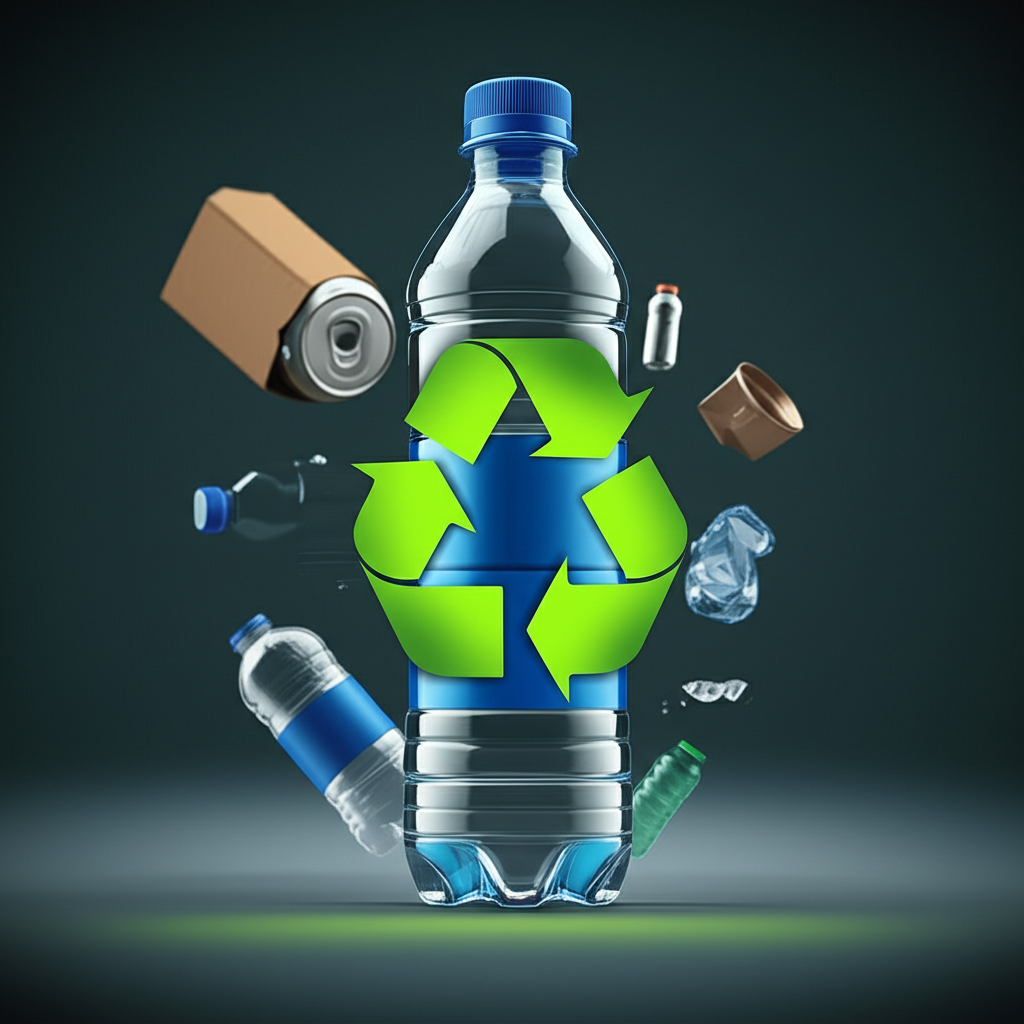Don't Be Fooled by the "Recyclable" Label: Understanding the Harsh Reality Behind Packaging Recycling Rates
Introduction: The Gap Between the Promise of "Recyclable" Labels and Reality
We've all seen those dazzling "recyclable" symbols on packaging. Whether it's the beverage bottles or takeout containers we buy every day, or the meticulously designed Branded Packaging from brands, they all seem to promise us: this is a responsible choice, it will be reborn, not become waste. As consumers, we naturally assume that as long as we throw it into the "recyclables" bin, we've done our part. But what's the truth? The truth is much more complex, and much harsher.
Today, I want to tear apart this beautiful lie and delve into the complex truth behind the "recyclable" label. The grim reality of packaging recycling rates worldwide, and the deep-seated reasons behind it, will probably shock you. There is a seemingly insurmountable chasm between "recyclables" and "being recycled."
Deconstructing "Recyclable": A Complex and Misunderstood Term
Do we really understand the word "recyclable"? I'm telling you, it's not a simple concept at all. It can even be said that it's a term that's severely misunderstood in different contexts.
The Sorrow of Definition: Differences in "Recyclable" Standards Across Countries and Regions
"Recyclable"? This is not a globally unified "medal" at all. It is influenced by local laws, technological levels, and market demands, which makes the concept itself vague. The "Green Dot" symbol you see in the European Union may mean that the producer has paid for the recycling fee, but it doesn't mean that the packaging will definitely be recycled. The recycling symbol in the United States (the triangle of chasing arrows) usually only represents that the material is "theoretically" recyclable. As for China, although there are clear recycling classification guidelines, the standards vary greatly when it comes to implementation. This inconsistency leaves consumers at a loss and gives brand owners a headache when promoting sustainable Custom Packaging.
The Challenge of Materials: Not All Materials Can Be Effectively Recycled
This is the most frustrating point. From a materials science perspective, not all materials labeled "recyclable" can be effectively recycled. Those seemingly ordinary potato chip bags and toothpaste tubes, even with "recyclable" labels, are difficult to recycle in practice. Why? Because they are usually multi-layer composite materials, tightly bonded from different plastics, aluminum foil, and even paper. Separating these materials is extremely complex technically and costly, making it economically unfeasible. The recycling process requires extremely high material purity. Food residues, glue, and ink, these "uninvited guests," can easily contaminate the entire recycling batch. For brands committed to Custom Packaging Design, this is undoubtedly a huge challenge: how to find a truly recyclable balance between creativity and functionality?
Infrastructure Bottlenecks: The Lack and Inefficiency of Recycling Systems
Even if your packaging is theoretically recyclable, even if you throw it into the recycling bin correctly, it may not reach the point of "rebirth." Why? Because our current recycling infrastructure is a leaky and inefficient system. The differences between urban and rural recycling systems are huge, and the coverage of recycling sites is surprisingly low. More critically, the sorting, transportation, sorting, and reprocessing links of recycling are simply a disaster. Backward sorting technology, a shortage of recycling workers, and limited processing capacity, these problems are superimposed, resulting in a large number of items that should have been recycled being sent to landfills or incinerators. Our enthusiasm for recycling is often ruthlessly consumed by this broken system.
Revealing the Truth: The Cruel Data and Underlying Reasons Behind Packaging Recycling Rates
Now, let's face those cold numbers. They will ruthlessly reveal the harsh reality behind the "recyclable" label.
Disappointing Recycling Data: Actual Recycling Rates in Global and Major Markets
Stop confusing "collected" with "actually recycled." There is a Pacific Ocean between the two. According to reports from the Ellen MacArthur Foundation and the United Nations Environment Programme, the actual recycling rate of global plastic packaging may be less than 10%, and some data even indicate that less than 2% of plastic packaging can truly achieve "closed-loop" recycling. The recycling rates of paper and glass are relatively high, but still far below our imagination. This means that even if your Branded Packaging has the most beautiful recycling symbol printed on it, in most cases, its final destination is still a landfill.
Insufficient Economic Drivers: The Profitability Dilemma of the Recycling Industry
We must admit that the recycling industry is not a charity. It also needs to be profitable. But the reality is that the collection, sorting, cleaning, and reprocessing of recyclables are all costly. However, the market price of recycled materials fluctuates like a roller coaster. In many cases, it is even more expensive than virgin materials. Why? Because it is often cheaper and more stable to manufacture new materials from scratch. When recycling lacks sufficient commercial incentives, this industry is difficult to sustain. Who would be willing to do a losing business? This has led to the profitability dilemma of the recycling industry and made the "green premium" a reality that some companies have to face.
Consumer Behavior Misconceptions: "Wishcycling" and Incorrect Sorting
Frankly speaking, we consumers also play an inglorious role in this "recycling dilemma." We often make a mistake that I call "wishcycling." It's that mentality of "who cares, it's better to throw it in the recycling bin than the regular trash can." A pizza box covered in food residue, a toy mixed with different materials, these "unqualified" recyclables, once they enter the sorting line, not only cannot be recycled themselves, but may even contaminate the entire batch of qualified recyclables, causing the entire batch to be scrapped. This not only reduces the overall recycling rate but also damages the image of those companies that invest resources in promoting sustainable Branded Packaging. Consumers will eventually find that the "sustainable packaging" you promised has not been effectively recycled, which may cause disappointment or even negative reviews. The pollution caused by this misclassification further increases the cost of the recycling industry chain. Ultimately, these costs are likely to be passed on to the production of Custom Packaging. We lack clear, uniform, and easy-to-understand recycling guidelines.
Beyond the Label: How to Promote Truly Sustainable Packaging Design and Recycling
We cannot stop at exposing the problem, but must find solutions. This requires joint efforts from brand owners, designers, policymakers, and consumers to truly achieve the recycling of packaging.
Design from the Source: Innovative Packaging Design Oriented to Recycling
The core of the problem lies in the design end. In the initial stage of Custom Packaging Design, we must consider its end-of-life. This means promoting the principle of "Design for Recyclability": simplifying materials, avoiding multi-layer composites, and making it easy to separate. For example, a bottle made of a single material (such as PET), even if its shape is slightly simple, is far more meaningful than a multi-layer composite, "beautiful" packaging full of various accessories. Carefully select renewable and biodegradable materials, and clearly distinguish the boundaries between "biodegradable" and "recyclable," which is crucial. At the same time, lightweighting packaging and reducing overpackaging are fundamental solutions that fundamentally reduce resource consumption. Choosing a professional Custom Packaging Design partner is the key first step for brands to achieve a truly sustainable commitment. When your Custom Packaging Design is truly recyclable, your Branded Packaging can truly fulfill its environmental promise.
The Responsibility of Brand Owners: Transparent Communication and Recycling Guidance
Brand owners, it's time to go beyond simple "recyclable" labels. Your Branded Packaging needs to become a "navigator" for consumers to recycle. Use QR codes or AR technology to guide consumers to obtain the most accurate local recycling guidelines. Brands should actively explore cooperation with professional Custom Packaging or recycling solution providers to jointly develop innovative recycling channels and consumer education programs. You can even try to introduce consumer recycling incentive mechanisms, such as reward programs through points, coupons, etc., to increase their participation. Some brands are already at the forefront. They invest in recycling projects and promote recycling education. Their Custom Packaging and Branded Packaging truly reflect sustainability.
Promoting Policy and Technological Progress: Building a More Complete Recycling Ecosystem
This is not a one-sided problem for brands or consumers. It is a systemic challenge that requires strong promotion by government policies. The practice of Extended Producer Responsibility (EPR) worldwide has proven that it can effectively promote companies to be responsible for the life cycle of packaging. At the same time, we urgently need to invest in the research and development of new technologies, such as the application of artificial intelligence (AI) and machine vision in intelligent sorting, which can greatly improve recycling efficiency and purity. Emerging technologies such as chemical recycling and biodegradation, although still in their early stages, undoubtedly paint a broader blueprint for future recycling systems. The EU's plastic tax and intelligent sorting robots are changes we are seeing.
Frequently Asked Questions (FAQ)
- Can packaging with a recycling symbol definitely be recycled? No, not necessarily. The recycling symbol usually only represents that the material is "theoretically" recyclable, but whether it is actually recycled depends on the local recycling system, material purity, and the economic benefits of recycling.
- How do I know if my packaging is really recyclable and where to recycle it? This is indeed difficult. The most accurate method is to consult your local municipal recycling guidelines. Some advanced brands will provide detailed recycling instructions through QR codes or cooperate with third-party platforms to provide recycling location query services.
- As a consumer, what can I do to improve recycling rates? The most important thing is "correct sorting" and "clean recycling." Make sure your recyclables are clean, dry, and correctly sorted according to local regulations. Avoid "wishcycling."
- What role do brand owners play in packaging sustainability? Play a core role. Brand owners have a responsibility to carry out Custom Packaging Design from the source, prioritize easily recyclable single materials, and provide consumers with clear recycling guidelines. They should also invest in or support the construction of recycling infrastructure.
Conclusion: Re-examining the True Meaning of "Sustainable"
The "recyclable" label is just the first step towards sustainability, not the end. We must clearly recognize that the transition from "surface recyclable" to "truly recycled" requires the joint efforts and a shift in thinking of the entire society. Building a true circular economy model that integrates the design, production, consumption, and recycling of packaging into a closely connected closed loop is our only way out.
Calling on all brand owners and designers, when conducting Custom Packaging Design, please deeply consider the environmental impact of its entire life cycle, go beyond the superficial "green" label, and commit to truly sustainable Branded Packaging solutions. What can we do for the future to make every "recyclable" label live up to its name?

